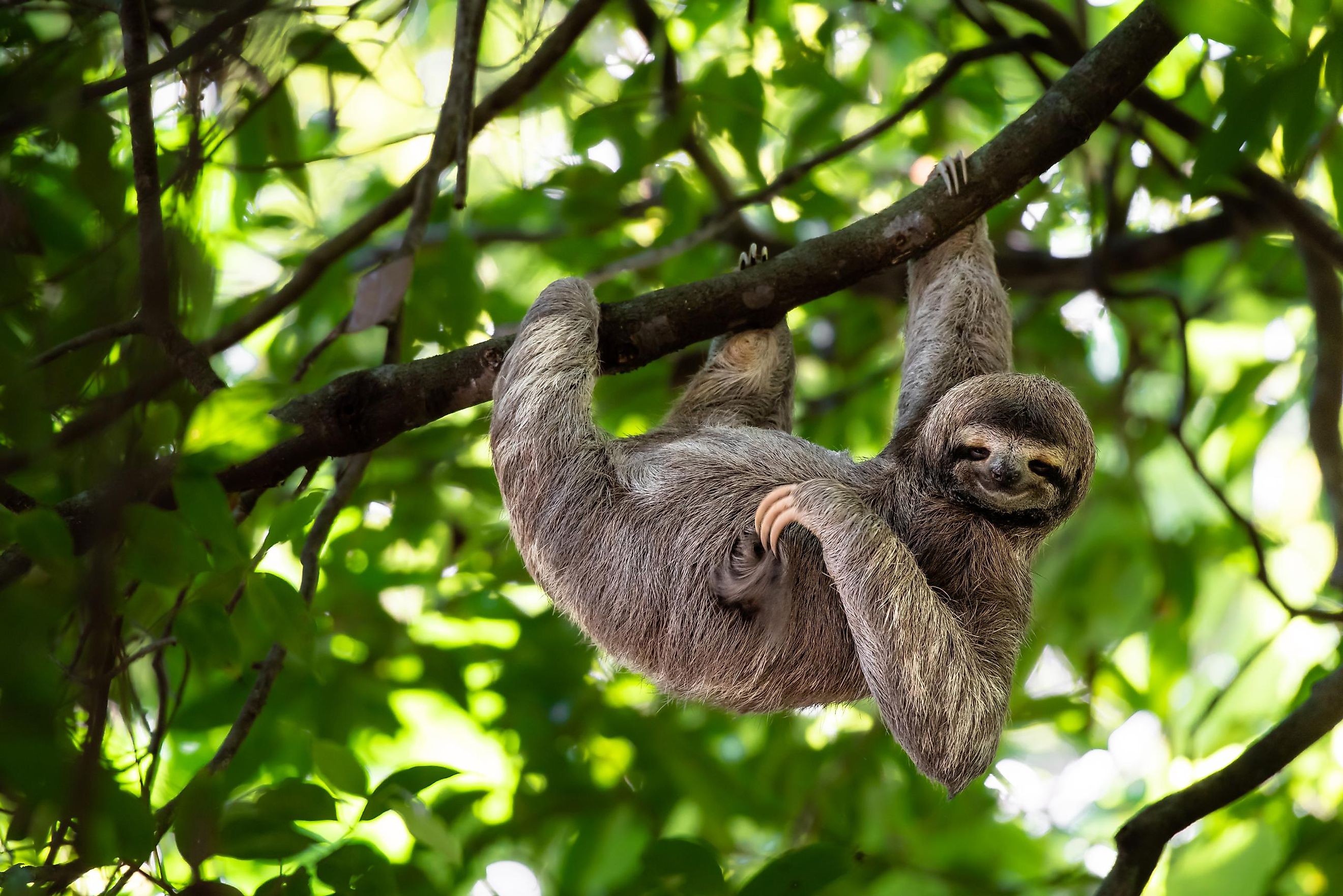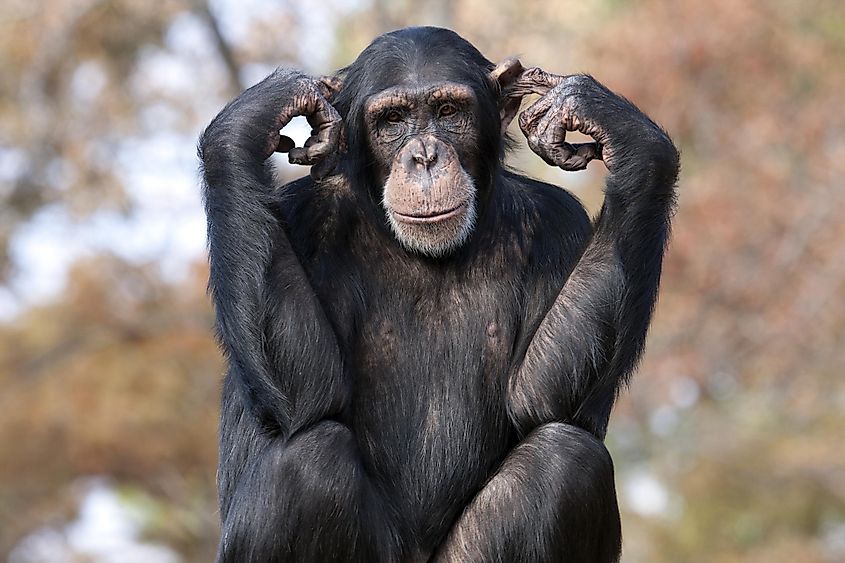
What Animals Live In The Tropical Rainforest?
Tropical rainforests range between the Tropic of Cancer and the Tropic of Capricorn (in places with high annual precipitation), and extend for much of the Earth's circumference. These areas are rich in biodiversity, with as much as half of all known species of flora and fauna residing under their dense canopy. Of that impressive census, there are some iconic animals that instantly spring to mind. Here are eleven such specimens that reside in the tropical rainforests of the world.
Jaguar

The preternatural beauty and affiliated terror of the jaguar (Panthera onca) cause admirers and prey to freeze in their tracks. The stand-out spots are similar to the leopards of Africa and Asia, but a small dot in the center is the key point of differentiation. The jaguar is the biggest cat in the Americas and the third biggest in the world (behind lions and tigers). These magnificent carnivores are solitary but highly-effective night hunters, both on land and in the water. They have even been known to attack caimans. Jaguars are classified as Near Threatened on the International Union for Conservation of Nature's Red List. Since the 1880s, they have lost nearly half of their territory and continue to face threats from poachers and retaliatory killings by cattle ranchers. Jaguars rely on the Amazon Basin and some parts of Central America, for their survival.
Gorillas

The largest of the great apes can be found throughout equatorial Africa. The western gorilla (Gorilla gorilla), which includes the two subspecies: the western lowland gorilla and the Cross River gorilla, is separated from the two subspecies of the eastern gorilla (Gorilla beringei): the eastern lowland gorilla and the mountain gorilla, by about 560 miles of dense Congo Basin forest. These fascinating and imposing primates can grow between four to six feet in height and weigh up to 440 pounds. Their collective population is estimated between 100,000 and 200,000 and has generally decreased for decades due to hunting, disease, and habitat loss. With the help of tourism, the one exception to this trend is the mountain gorilla, which was recently upgraded from Critically Endangered to Endangered.
Green Anaconda

This member of the boa family is the largest species of snake in the world. It can reach lengths of 20 - 30 feet (i.e., as long as a school bus), with a diameter of 12-inches, and weigh upwards of 550 pounds. The reticulated python can grow slightly longer, but the green anaconda (Eunectes murinus) is nearly twice as heavy. They reach these astounding girths through a diet of wild pigs, deer, birds, capybaras, caimans, and, believe it or not, jaguars. These non-venomous giants asphyxiate their prey before swallowing it whole. After a big meal, anacondas can go months without food. Because of their size, anacondas are slow-moving on land but surprisingly mobile in the water. They mainly live in the Amazon and Orinoco basins, though exact population data and the overall status of the species are unknown.
Blue Morpho Butterfly

The bright blue wings of the blue morpho butterfly (Morpho peleides) can be found in the rainforests of Latin America, stretching from Mexico down to Colombia. The brilliant hue across their five to eight-inch wingspan makes them one of the world's largest and most iconic butterflies. While the top, light-reflecting side catches the eye, the muted, brown underside of the blue morpho's wings does the exact opposite, camouflaging its vulnerable body against predators (and even repelling them with the illusion of many attentive eyes).
Sloths

These loveable slow-pokes also mostly snooze life away in the rainforest canopy. They tend to sleep between 15 - 20 hours a day, and when it is time to feed, they cover a whopping 40 yards, collecting leaves, twigs, and buds along the way. Despite their morose movements, sloths always seem to have a smile on their face. They even enjoy a leisurely swim from time to time - putting those long, tree-hanging arms to a secondary use. There are two different types of sloths, two-toed and three-toed, as well as six species (all of which are found within Central and South America). Of these, the pygmy three-toed sloth (Bradypus pygmaeus), is listed as Critically Endangered, and the maned sloth (Bradypus torquatus) is classified as Vulnerable.
Chimpanzee

Chimpanzees (Pan troglodytes) are our closest living relative (roughly 98.7% genetic similarity with humans). Like us, they are highly social primates, living in communities consisting of several dozen members that embody specific roles and exhibit unique personalities. Their habitats consist of the rainforests, savannah woodlands, and grasslands of Central and West Africa, though like the gorilla, they face continual threats from human activity and disease. Currently, chimps are listed as Endangered.
Black Caiman

The Black caiman (Melanosuchus niger) is the largest animal in the Amazon Basin. It is also the largest species of alligator, typically ranging from 9 - 14 feet (but able to grow as long as 20 feet), and weighing anywhere from 209 to over 660 pounds. Aside from its impressive size, the Black caiman also differs from the American alligator because of its dark-colored, armored skin (hence the name). This adaptive trait improves the nocturnal hunter's camouflage, and may also help absorb heat during the day. If left to their own devices, these alligators can live upwards of 80 years. However, in the past century, this species was reduced by about 99%, mostly due to heavy hunting in order to produce black leather. Thankfully, they have recently rebounded sufficiently to be categorized as Least Concern.
Okapi

The Okapi (Okapia johnstoni), or "forest giraffe," is quite a curious-looking creature. Though easily one of the most attention-grabbing animals of the rainforest, it is estimated that the population of okapis has been halved over the last twenty years. As it stands, the only habitat that supports wild okapis is the Ituri Rainforest in the Democratic Republic of Congo. While this sizable herbivore has to be continually vigilant about leopards, its primary threat is, once again, humans. Due to the ongoing conflicts in this region, it has proved difficult to crack down on poachers. This, combined with deforestation, makes the okapi an Endangered species.
Harpy Eagle

The Harpy eagle (Harpia harpyja) is one of the biggest eagles in the world and easily the largest and most dominant raptor in the Amazon rainforest. This carnivorous predator has a wingspan of 69 to 88 inches, the largest talons of any living eagle, and the ability to lift prey equal to its body weight (i.e., 9 to 20 pounds). The Harpy eagle can also reach a sizzling top speed of 50 miles per hour. It uses these tools to hunt a wide array of animals, including sloths, monkeys, porcupines, squirrels, anteaters, iguanas, snakes, other birds (and their eggs), such as the macaw, and many more. Even though Harpy eagles have a vast territory, spanning from Mexico down to Argentina, their numbers are declining to the point of being considered Near Threatened.
Macaw

These brightly colored birds belong to the parrot family. Their plumage is well-matched to their habitat of green trees, tasty fruits, and pretty flowers. Macaws (Psittacidae) are omnivorous, using their beaks to crack nuts and seeds and their tongues specially designed with an interior bone to tap into nutritious fruits. They also use their gripping toes to catch insects and snails. These birds are intelligent and highly vocal. They typically congregate in flocks of 10 to 30, calling out proudly to one another. Famously, some species are known to mimic human speech. There are 17 documented species of macaws. The red-fronted and blue-fronted species are seriously at-risk, while the glaucous and Spix's macaw species are possibly already extinct in the wild. Pressures on the macaw relate to habitat destruction and their popularity as pets, which causes them to be captured and traded illegally.
Howler Monkey

You can hear the ominous call of these New World monkeys from a mile away - 3 miles away, actually. Those brave enough to seek the source of the demonic wail will spot the large canopy-dwellers by their beards, swollen throats (owing to an enlarged hyoid bone at the base of the tongue), and most commonly, dark red fur (though they may also be black, brown, or gold). Howler monkeys assume the role of rainforest roosters, waking up the jungle bright and early. They do this again before going to bed, in both cases as a signal to males in other groups, thereby defining their distinct territories. Though they sound frightening, howlers predominantly subsist on flowers, leaves, and fruit. The population of red howler monkeys (Alouatta seniculus) has the widest distribution and is listed as Least Concern, though other species, such as the black howler (Alouatta pigra), has been Endangered since 2003.
Though vital biomes for untold numbers of species, and invaluable producers of oxygen and medicines, tropical rainforests battle continual human encroachment and corresponding deforestation. These eleven spectacular animals, most of which are currently struggling to sustain their populations, serve as powerful mascots for ongoing conservation efforts.











